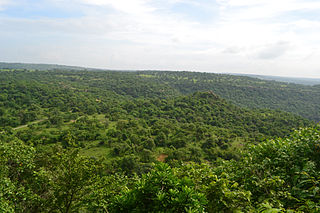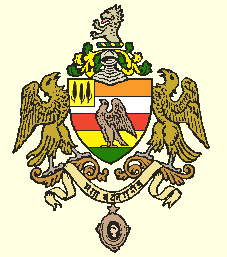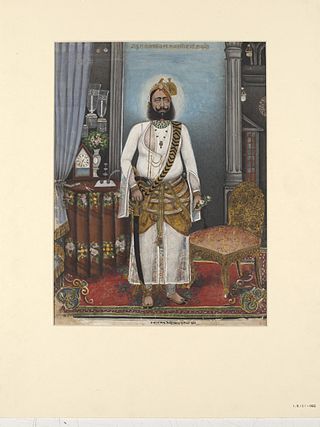Rājpūt, also called Thākur, is a large multi-component cluster of castes, kin bodies, and local groups, sharing social status and ideology of genealogical descent originating from the northern part of the Indian subcontinent. The term Rajput covers various patrilineal clans historically associated with warriorhood: several clans claim Rajput status, although not all claims are universally accepted. According to modern scholars, almost all Rajput clans originated from peasant or pastoral communities.

Lieutenant-Colonel James Tod was an officer of the British East India Company and an Oriental scholar. He combined his official role and his amateur interests to create a series of works about the history and geography of India, and in particular the area then known as Rajputana that corresponds to the present day state of Rajasthan, and which Tod referred to as Rajast'han.

Sonbhadra or Sonanchal is the second largest district by area of Uttar Pradesh after Lakhimpur Kheri. The district headquarters is in the town of Robertsganj. Sonbhadra is also known as the "Energy Capital of India" for hosting multiple power plants.

Kurmi is traditionally a non-elite tiller caste in the lower Gangetic plain of India, especially southern regions of Awadh, eastern Uttar Pradesh and parts of Bihar and Jharkhand. The Kurmis came to be known for their exceptional work ethic, superior tillage and manuring, and gender-neutral culture, bringing praise from Mughal and British administrators alike.

The Rathore dynasty or Rathor dynasty was an Indian dynasty belonging to the Rathore clan of Rajputs that has historically ruled over parts of Rajasthan, Gujarat and Madhya Pradesh. The Rathores trace their ancestry to the Rashtrakutas and later to the Gahadavalas of Kannauj, migrating to Rajasthan after the fall of Kannauj.
Rajput is a large multi-component cluster of castes, kin bodies, and local groups, sharing social status and ideology of genealogical descent originating from the Indian subcontinent. The term Rajput covers various patrilineal clans historically associated with warriorhood: several clans claim Rajput status, although not all claims are universally accepted. According to modern scholars, almost all Rajputs clans originated from peasant or pastoral communities.
A Bhilala is a tribe found in the Malwa and Nimar of the Central Provinces and in Central India. The total strength of the Bhilalas is about 150,000 persons, most of whom reside in the Bhopawar Agency, adjoining Nimar. Only 15,000 were returned from the Central Provinces in 1911. The Bhilalas are commonly considered, and the general belief may in their case be accepted as correct, to be a mixed caste sprung from the invading immigrant Rajputs with Bhils of the Central India hills. The original term was not improbably Bhilwala, and may have been applied to those Rajput chiefs, a numerous body, who conquered small estates in the Bhil country, or to those who took the daughters of Bhil chieftains to wife. The bhilalas in the central province are descendants of male Rajput with female Bhils and take the name of the Rajput clan to which they trace their origin. The Bhilalas are landholders and live like mukhis, darbar or thakur.

Satna District is a district of Madhya Pradesh state in central India. The city of Satna is the district headquarters. The district has an area of 7,502 km2, and a population of 22,28,935(2011 census), 20.63% of which is urban. The district has a population density of 249 persons per km2.
Dalwal is a village and union council, an administrative subdivision, of Chakwal District in the Punjab Province of Pakistan, it is part of Choa Saidan Shah Tehsil and is located at 32°42'0N 72°52'60E

Singrauli district is one of the districts in the Indian state of Madhya Pradesh. It is a significant hub for energy production due to its vast coal reserves and power plants, earning it the title "Energy Capital of India."
Kanet is a caste found in India natively residing in the state of Himachal Pradesh. Historically, Kanets have been engaged in agriculture and allied activities. They also generally use as a Thakur title.There is a major subcaste of kanets which is known as "Mukhiya".

The Lodhi is a community of agriculturalists, found in India. There are many in Madhya Pradesh, to where they had emigrated from Uttar Pradesh. The Lodhi are categorised as an Other Backward Class, but claim Rajput ties and prefer to be known as "Lodhi-Rajput", although they have no account of their Rajput origin or prevailing Rajput traditions.
Kharwar is a surname used by odh found in the Indian states of Uttar Pradesh, Bihar, Jharkhand, Chhattisgarh, Orissa and West Bengal in India and Sindh in Pakistan.

Thakur is a historical feudal title of the Indian subcontinent. It is also used as a surname in the present day. The female variant of the title is Thakurani or Thakurain, and is also used to describe the wife of a Thakur.
The Orh is a drifting tribe of labourers in Sindh, Gujarat, Kathiawar, and some parts of Rajasthan. They drift and shift lock, stock, and barrel with their families wherever work is to be done. They are said to hold a variety of occupations. As artisans, they are carpenters, masons and stoneworkers and were considered to be Dalits. As traders, they deal in grain, spices, perfumes, and cloth. They are spread across 40 villages in Uttarakhand and Uttar Pradesh. In reality, Odh is a word for people who built mud huts rather than a caste; yet, but it is used as a caste in Pakistan. They claim their original name was Sagarbansi or Sagarvanshi they bear surnames like Gadahi, Bhagat, Galgat, Kharwar, Kahlia, Kudavali, Maangal, Majoka, Mundai, Sarvana, and Virpali.

Surguja State was one of the main princely states of Central India during the period of the British Raj, even though it was not entitled to any gun salute. Formerly, it was placed under the Central India Agency, but in 1905 it was transferred to the Eastern States Agency.

Agori Fort is a fort located about 10 km from Chopan near Obra at riverside of Son River, in the Sonbhadra district, which is 35 km from Robertsganj, on SH 5 Road in the Sonbhadra district, Uttar Pradesh India. There is a temple of Hindu deity Kali.This is religious place for the Agori Baba.Agori Fort was the residential palace of the Khayaravala and Chandel dynasties.
Rajputs of Nepal or anciently Rajputras are Rajput Kshatriya community of Nepal.
Modern historians agree that Rajputs consisted of a mix of various different social groups and different varnas. Rajputisation explains the process by which such diverse communities coalesced into the Rajput community.
Akhil Bharatiya Kshatriya Mahasabha also known as All India Kshatriya Mahasabha was founded in the year 1897 It was formed to promote, protect and fight for rights and interests of Rajput community of the Indian society.










